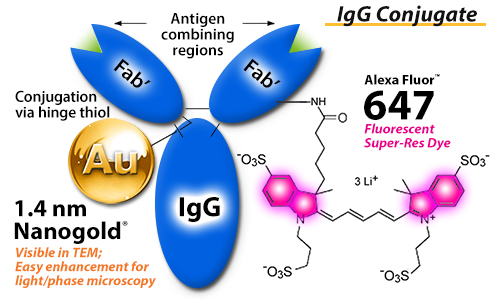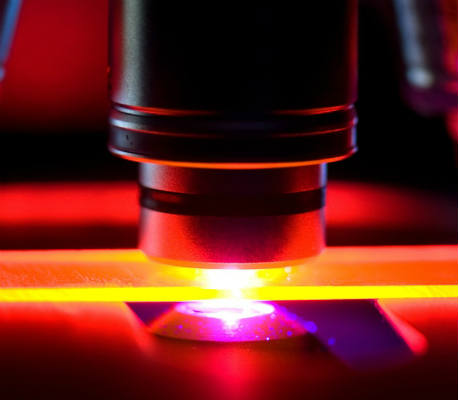41 fluorescent labels and light microscopy
Fluorescent Label - an overview | ScienceDirect Topics 14.3.2Fluorescence quenching microscopy Fluorescence microscopy is a very common tool. Usually, fluorescent labelsare used to brighten up the object of interest. However, the same strategy is not applicable for graphitic materials, such as graphite, graphene, GO or r-GO as they are strong quenchers of dye molecules [45]. Choosing Fluorescent Proteins for Dual Labeling Experiments This interactive tutorial explores matching fluorescent proteins for dual labeling investigations with regards to spectral bandwidth and overlap, excitation efficiency, emission window dimensions, and other parameters necessary to design logical experiments. This tool should thus help inform choice of fluorescence filter combination.
The Light Sheet Microscopy Principle - ZEISS The unique Multiview light sheet fluorescence microscope allows you to record the development of large, living samples and gently image them to deliver exceptionally high information content. It is also fast: Lightsheet 7 is your microscope for optical sections at high speed. Acquire images of your whole sample volume at sub-cellular resolution ...
Fluorescent labels and light microscopy
Label-free prediction of three-dimensional fluorescence images from ... We present a label-free method for predicting three-dimensional fluorescence directly from transmitted-light images and demonstrate that it can be used to generate multi-structure, integrated... Fluorescence Microscopy vs. Light Microscopy - Medical News This means that fluorescent microscopy uses reflected rather than transmitted light. For example, a commonly used label is green fluorescent protein (GFP), which is excited with blue light and... Different Ways to Add Fluorescent Labels - Thermo Fisher Scientific Using fluorescence provides greater contrast compared to viewing your samples with brightfield microscopy alone. Labeling various targets with separate fluorescent colors allows you to visualize different structures or proteins within a cell in the same experiment.
Fluorescent labels and light microscopy. New Fluorescent Label Illuminates Cancer Samples In superresolution fluorescence microscopy, a molecule is labelled with a special fluorescent dye that flashes on and off like a blinking star. Unlike traditional fluorescence microscopy, which uses labels that glow constantly, this approach involves switching on only a subset of the labels at each moment. Label-free prediction of three-dimensional fluorescence images from ... Label-free prediction of three-dimensional fluorescence images from transmitted-light microscopy Understanding cells as integrated systems is central to modern biology. Although fluorescence microscopy can resolve subcellular structure in living cells, it is expensive, is slow, and can damage cells. Fluorescent labels, confocal microscopy, and quantitative image ... Fluorescent labels, confocal microscopy, and quantitative image analysis in study of fungal biology. Methods Enzymol. 1999;307:607-23. doi: 10.1016/s0076-6879 (99)07036-6. Fluorescence Imaging - Teledyne Photometrics Fluorescent molecules (known as fluorophores) are used to label samples, and fluorophores are available that emit light in virtually any color. In a fluorescent microscope, a sample is labeled with a fluorophore, and then a bright light ( excitation light) is used to illuminate the sample, which gives off fluorescence ( emission light ).
Learn about fluorescent labels and light microscopy | Echemi Provide different insights into fluorescent labels and light microscopy on echemi.com. We offer a huge of fluorescent labels and light microscopy news and articles here. ... Fluorescent Brightener. Plastic Rubber Chemicals. Polymer. Precious Metal Catalysts. Zeolite. Flame Retardants. Petrochemical. Natural Products. Lignans. Xanthones ... Fluorescent Labeling - What You Should Know - PromoCell Fluorescence microscopy allows the identification of cells and cellular components and the monitoring of cell physiology with high specificity. Fluorescence microscopy separates emitted light from excitation light using optical filters. The use of two indicators also allows the simultaneous observation of different biomolecules at the same time. Label-free imaging of live cells | CytoSMART A non-invasive and non-toxic alternative to fluorescent microscopy is label-free imaging. Here, a combination of contrast-improving optics and image analysis algorithms are used to analyze cell cultures. ... Thorn, K. A quick guide to light microscopy in cell biology. Molecular Biology of the Cell 27, 219-222 (2016). Walker-Daniels, J. Live ... Fluorescent labeling of abundant reactive entities (FLARE) for cleared ... Fluorescence microscopy is a technique that is commonly used in the biomedical sciences. It offers the powerful ability to visualize structures or molecules in three dimensions within biological...
Fluorescence Microscopy vs. Light Microscopy - New York Microscope Company Comparing Light vs Fluorescence Light microscopes use light in the 400-700nm range - the range through which light is visible to the human eye - but fluorescence microscopy uses much higher intensity light. Because traditional light microscopy uses visible light, the resolution is more limited. Fluorescent Labels, Confocal Microscopy, and Quantitative Image ... Fluorescent labels have great utility because they are relatively ... of UV or blue light and oxygen, i.e., without cofactors or substrates. 6 . Another major area of recent technical advance considered in this article ... Fluorescent Labels, Confocal Microscopy, and Quantitative Image Analysis in Study of Fungal Biology ... In silico labeling: Predicting fluorescent labels in unlabeled images Microscopy is a central method in life sciences. Many popular methods, such as antibody labeling, are used to add physical fluorescent labels to specific cellular constituents. 1.2 Fluorescence Light Microscopy - Cell Structure The addition of fluorescence to light microscopy allows us to look not just at cells, but for things inside them. Specific cellular components can be fluorescently labeled, with a stain or antibody that binds a particular molecule.
Fluorescent tag - Wikipedia Fluorescent tag. S. cerevisiae septins revealed with fluorescent microscopy utilizing fluorescent labeling. In molecular biology and biotechnology, a fluorescent tag, also known as a fluorescent label or fluorescent probe, is a molecule that is attached chemically to aid in the detection of a biomolecule such as a protein, antibody, or amino acid.
Fluorescent Labelling - an overview | ScienceDirect Topics Fluorescence microscopy Fluorescent labeling methods are generally based on reactive derivatives of fluorophores that selectively bind to functional groups contained in target biomolecules and are widely used in biotechnology because of their non-destructive properties and the high sensitivity of fluorescence techniques ( Sahoo, 2012 ).

Label-free prediction of three-dimensional fluorescence images from transmitted-light microscopy ...
Fluorescence or label-free imaging? Custom microscopy illumination ... For live cell imaging, label-free microscopy is a popular method which comes with several advantages. Unlike fluorescence microscopy, there are no labels that could potentially interfere with the phenomenon you want to observe. It also requires lower light levels, which is great for reducing photodamage.
Fluorescence Microscope: Principle, Types, Applications Epifluorescence microscopes: The most common type of fluorescence microscope in which, excitation of the fluorophore and detection of the fluorescence are done through the same light path (i.e. through the objective).; Confocal microscope: In this type of fluorescence microscope, high‐resolution imaging of thick specimens (without physical sectioning) can be analyzed using fluorescent ...
Light Microscope- Definition, Principle, Types, Parts, Labeled Diagram ... A light microscope is a biology laboratory instrument or tool, that uses visible light to detect and magnify very small objects and enlarge them. They use lenses to focus light on the specimen, magnifying it thus producing an image. The specimen is normally placed close to the microscopic lens.
Label-free prediction of three-dimensional fluorescence images from ... Fluorescence microscopy can resolve subcellular structure in living cells, but is expensive, slow, and toxic. Here, we present a label-free method for predicting 3D fluorescence directly from transmitted light images and demonstrate its use to generate multi-structure, integrated images.
Novel Fluorescent Label Shines a Light on DNA Structure in Cancer Cells Liu and her team formulated a new label called Hoechst-Cy5 to overcome the hurdle that fluorescent dyes didn't work well on DNA or in processed clinical cancer samples. After showing that the new...
In Silico Labeling: Predicting Fluorescent Labels in Unlabeled ... - Cell Fluorescence microscopy images can be predicted from transmitted-light z stacks • 7 fluorescent labels were validated across three labs, modalities, and cell types • New labels can be predicted using minimal additional training data Summary Microscopy is a central method in life sciences.
Fluorescence Microscopy - Explanation and Labelled Images Fluorescence microscopy uses a high-intensity light source that excites a fluorescent molecule called a fluorophore in the sample observed. The samples are labeled with fluorophore where they absorb the high-intensity light from the source and emit a lower energy light of longer wavelength.
Fluorescence Microscopy & Cell Imaging | Research | UNM Cancer Center Imaging. The Fluorescence Microscopy and Cell Imaging Shared Resource aids basic and physician researchers to image samples and publish high profile articles that: Elucidate cell and molecular mechanisms of cancer, immunologic, infectious, metabolic, neurologic and vascular diseases. Evaluate therapeutic efficacy in cells and patient samples.
Different Ways to Add Fluorescent Labels - Thermo Fisher Scientific Using fluorescence provides greater contrast compared to viewing your samples with brightfield microscopy alone. Labeling various targets with separate fluorescent colors allows you to visualize different structures or proteins within a cell in the same experiment.
Fluorescence Microscopy vs. Light Microscopy - Medical News This means that fluorescent microscopy uses reflected rather than transmitted light. For example, a commonly used label is green fluorescent protein (GFP), which is excited with blue light and...
Label-free prediction of three-dimensional fluorescence images from ... We present a label-free method for predicting three-dimensional fluorescence directly from transmitted-light images and demonstrate that it can be used to generate multi-structure, integrated...












Post a Comment for "41 fluorescent labels and light microscopy"